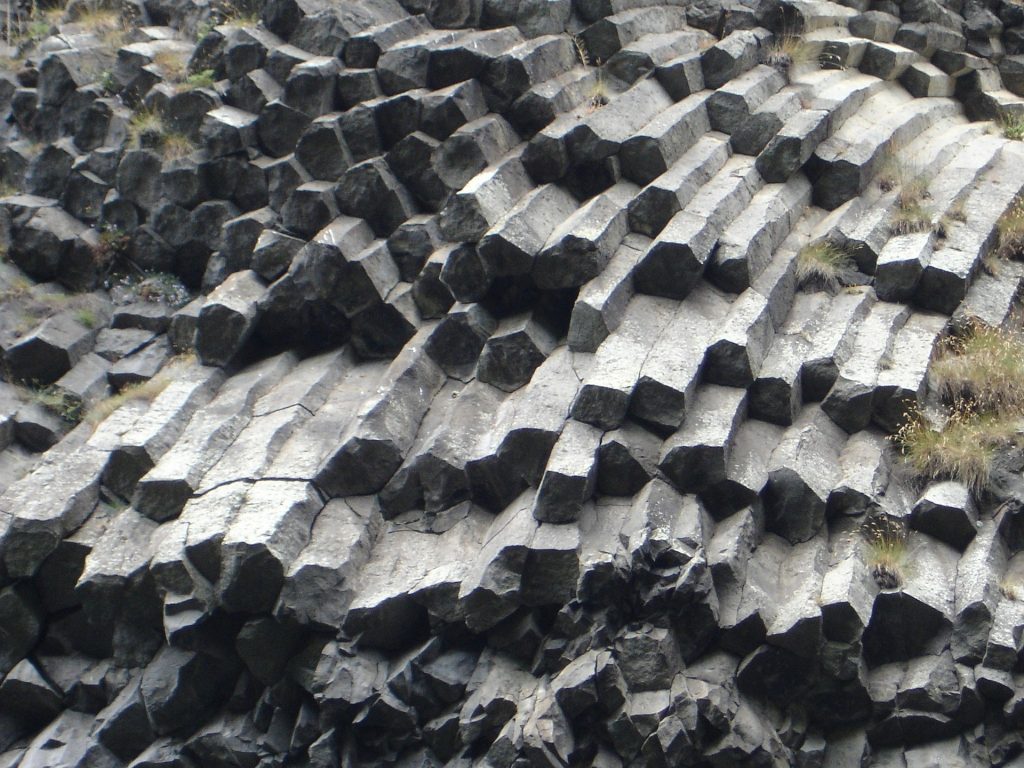(Image: Hans Braxmeier, Pixabay)
Basalt is a very fine-grained extrusive igneous rock consisting of calc-plagioclase (bytownite to labradorite) and pyroxene (commonly augite, pigeonite, and hypersthene), with apatite, magnetite, and olivine commonly present. Modal rock composition of mafic minerals is less than 90%. It has a similar composition to that of diabase (dolerite) and gabbro. Basalts form in a wide range of environments including mid-oceanic ridges, above subduction zones, and the volcanics of intra-plate continental and oceanic settings.
In Egypt basalt deposits are located in a number of locations. The main quarry for Old Kingdom basalt was at Fayum (Lucas and Harris, 1962), which is located at Gebel Qatrani (see map). These basalt deposits are a member of the Qatrani Formation and are of late Oligocene age (Siad, 1962) representing basalt surface flows, some of which are up to 25 m in thickness (Beadnell, 1905). The basalts of the Fayum are black in colour, fined-grained, and can be slightly porphyritic in texture (phenocrysts up to 7 mm). A polished rock slab image of basalt from Fayum can be seen at the Ancient Egyptian Quarries website (section #2). Other deposits of basalt are found at Abu Za’bal, northwest of the Giza pyramids, southwest of Samalut in the Cairo-Suez desert, Aswan, the Baharia desert, and in the Sinai and Eastern desert (Siad, 1962). There is little evidence that any of these other localities were quarried by the Egyptians in ancient times (Lucas and Harris, 1962). Many of the basalts of Egypt are of a more coarse-grained variety, which means that they are of a slightly intrusive nature and can also be called a fine-grained diabase (dolerite).
As a building material basalt was used by the ancient Egyptians mainly for pavement stones during the Old Kingdom period. This rock was used, before it was employed as a building stone, for the working of vases and axes heads as far back as Neolithic, Badarian, and Predynastic times (Lucas and Harris, 1962). Some of the earliest stone vessels in Egypt are made of basalt. It was also used for sarcophagi and statues during the Early Dynastic period. However, it should be pointed out that all that is named as basalt in the archaeological literature is not always basalt (Lucas and Harris, 1962; Penny, 1991). Many artifacts, such as sarcophagi, statues, vases, bowls, etc., are in actual fact made of a rock called greywacke or similar looking rocks of sedimentary, metasedimentary (siltstone, mudstone, slate and tuff), and igneous (granite) origin. These sedimentary, metasedimentary and igneous rocks are similar in both colour and/or texture, but not in terms of rock hardness. It is often difficult to distinguish between these types of rock from a visual inspection alone so the confusion is understandable.
References
Beadnell, H. J. L. (1905) The topography and geology of the Fayum province of Egypt. Egypt. Survey Dept., Cairo, 101 p.
Lucas, A. & Harris, J.R. (1962) Ancient Egyptian materials and industries. E. Arnold, London, 523 p.
Penny, N. (1993) The materials of sculpture. Yale University Press, New Haven, 318 p.
Said, R. (1962) The geology of Egypt. Elsevier, New York, 377 p.
Links to examples of basalt usage
a) Bowls
b) Vases
Predynastic period (Nagada I) basalt vase (E 23175) (height: 42.8 cm, Musée du Louvre, Paris.
c) Statues
Old Kingdom basalt healing statue from the 4th dynasty (height: 67.7 cm, Musée du Louvre, Paris).
Late period (26th Dynasty) basalt statue of a kneeling official (1988.4.1)(Michael C. Carlos Museum, Atlanta).

